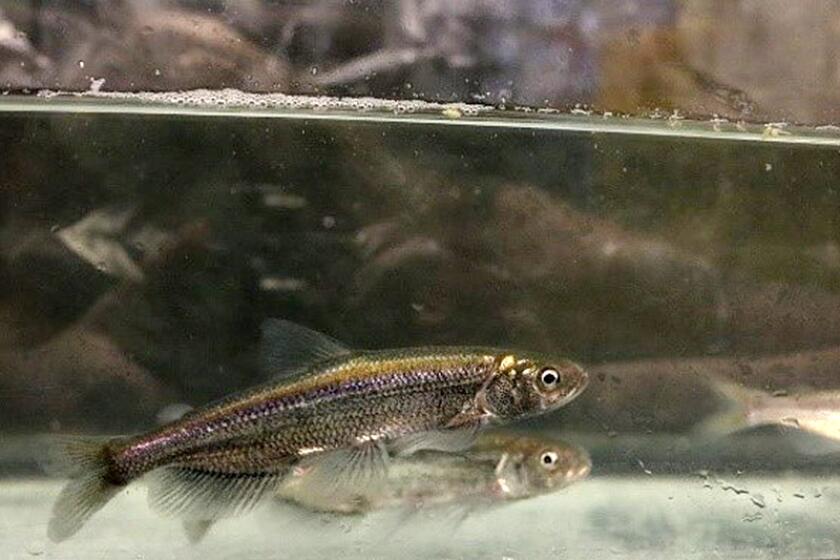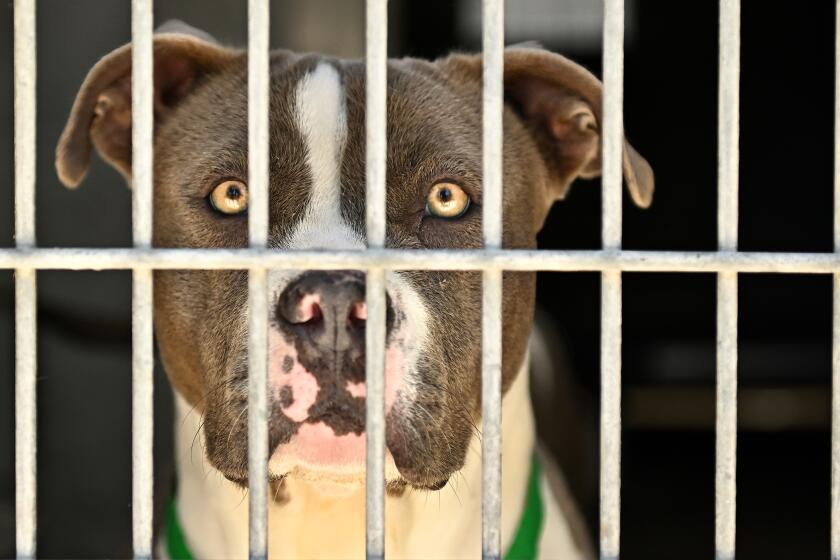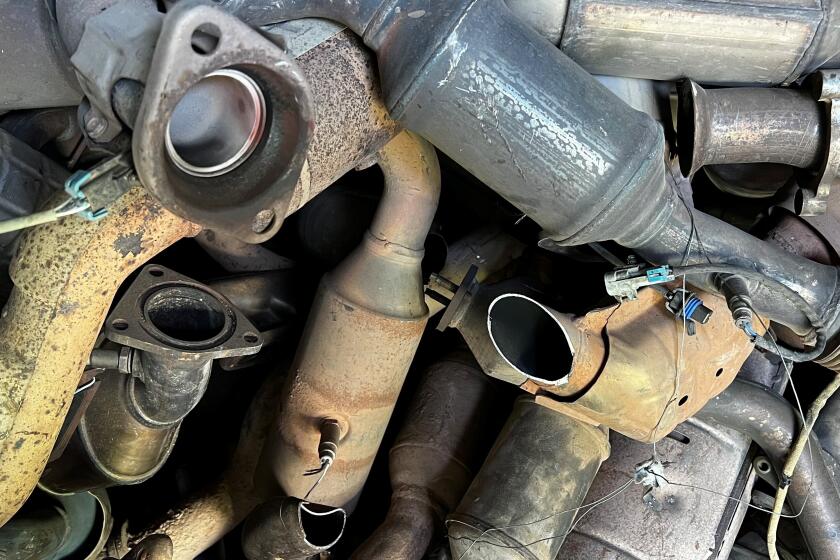Wily Coyotes, Learning to Live in the Suburbs, May Be Outfoxing Man
- Share via
Brooke had a daily ritual, and that’s what did her in.
As usual, Brooke began yipping and scratching at the back door of the Marrows’ place in La Mesa near San Diego just as the morning sun inched above the horizon. The dog’s owner, Kathleen Marrow, obediently let the small white terrier out into the back yard.
Predictably, Brooke headed for the soft earth beneath a leafy thicket of pepper trees just behind the oatmeal-colored house at the edge of a yawning valley carpeted with ragweed and eucalyptus.
On this morning, however, three coyotes lurked in the shadows. Before Brooke could even bark, the coyotes pounced on the startled little dog. It was no match. They dug their fangs into the terrier’s wiry white fur and dragged her off into the ravine.
Within minutes, Marrow began to wonder where the dog was. She checked the backyard. No Brooke. She looked along the side of the house. Nothing. Her husband, Tom, joined the hunt. Peering over the back fence, he spotted the coyotes huddled over the family’s prized pet, ripping at the dog’s bloody underbelly.
In a blind rage, he ran into the fray. Two of the coyotes trotted off, but the largest was defiant and refused to retreat. Marrow sprinted back up to the house for a club, a gun, anything to drive the animal away. When he returned, however, the coyote was gone, and so was Brooke.
“We never found anything, no remains, not even her license or collar,” Kathleen Marrow said. “I never thought the coyotes would do something horrible like this to our sweet little dog.”
While the coyote has been in Southern California about as long as the land itself, its conflicts with human beings have started to escalate only as subdivisions and shopping centers have crept farther into the once-desolate territory that has traditionally played host to the wily critter.
Once found primarily in the Southwest, the coyote has spread during this century to 49 of the 50 states. Only Hawaii has never had them. Mostly, the animal has remained in the wild, subsisting on a natural diet of rabbits and rodents. But in fast-growing Southern California, confrontations between humans and coyotes have become increasingly common.
That interaction primarily involves coyotes scavenging in garbage or nabbing pets, but on occasion the animal has attacked humans. The half-dozen incidents that have taken place in Southern California since 1980 have been in Orange and Los Angeles counties, where coyotes have stalked infants or small children left unattended in neighborhoods on the edge of the wilderness. In 1981, one young child died after she was mauled by a coyote in Glendale.
Three months ago, not long after a 2-year-old San Clemente boy was bitten on the leg by a coyote, a reserve police officer volunteered his years of experience as a hunter to try to reduce the growing number of encounters in the city between residents and the wild animals.
“When I started, the city was averaging 50 complaints a month of coyote activity in residential neighborhoods,” said Daniel R. Phillips, 40. “In October, there were 16 complaints.” By mid-November there had only been six complaints, he said.
The declining number of complaints, however, is not a signal that San Clemente’s coyote problem has been permanently solved; it is merely evidence that it is, for the time being, under control. So far this year, 22 coyotes have been killed in San Clemente, according to Fire Chief Tom Dailey, who also heads the city’s Animal Control Department. Phillips has been responsible for almost all of them.
Third Attack
The 2-year-old boy was the third child to be attacked in San Clemente within three years. And an ever-growing number of cats and small dogs have disappeared as the city’s perimeter has been pushed by development into hitherto unsettled hills and canyons.
In August, 1983, a 2-year-old boy suffered a minor bite while playing in his backyard in the southern part of San Clemente. A few days later, in the same neighborhood, a 2-year-old girl sustained serious injuries when one of the animals jumped her as she sat in the driveway of her home.
In the case of the girl, members of a newly organized police sharpshooter patrol were only a few blocks away and killed the coyote before it could leave the neighborhood.
The patrols were disbanded in late 1984 after 11 coyotes were killed. Now, according to Dailey, police officers do little shooting, but Phillips, a building contractor by profession, has taken over, spurred by the latest attack on a child in August.
Throughout the rest of Orange County, coyote activity is “rather spotty” compared to San Clemente, said Joe Oliver, chief of the county’s Animal Control Department.
“We’ve trapped and killed only five animals so far this year,” he said. “We haven’t had any reports of attacks on humans, but residents have lost a few cats and small dogs.”
Activity Down
Greg Hickman, instructor at the North Orange County Regional Occupation Program, which specializes in teaching animal care and is licensed by the state Department of Fish and Game to handle wild creatures, agreed with Oliver that coyote activity in most of the county “is down right now.”
But Hickman added that “we can expect a lot of trouble when people start moving into those new developments north of El Toro and around Trabuco Canyon.”
While San Diego County depends largely on a 24-member group called the National Predator Callers Assn. for coyote control, San Clemente relies on the lone hunter, Phillips, who conducts the only such program in Orange County.
Using a rifle, sometimes a shotgun, and on at least two occasions a bow and arrow, he has taken a total of 18 animals in three months.
“We use the hunting method rather than trapping or poisoning,” he said, “because it is totally selective. We identify trouble areas from log reports of sightings and encounters, and when I’ve taken one or two animals from those areas, the rest are intelligent enough to recognize that we’ve established a perimeter, and they respect the new boundaries.
“We think now that practically all those that lived within the city limits have been destroyed, and the others are learning that it’s not healthy to be within that perimeter.”
Adept at Surviving
The coyote is a clever animal, remarkably adept at surviving in both rural and urban worlds. In some cases, the animals have been surrounded by development, yet adapt themselves quite well to their new environment. Residents say they regularly spot coyotes roaming San Diego’s canyons, surviving against all odds in the greenbelts riddling such densely populated communities as Kensington and Clairemont.
“Coyotes are a natural part of the ecology around here,” said George Story, director of citizens assistance and information for the City of San Diego. “They’re in the outlying areas, but we’ve also got them in Mission Valley, Encanto. Just about any place there is food and a certain degree of cover and safety you’ll find the coyote. They’re about as common as the cockroach.”
Some experts contend that Southern California’s coyote population is growing despite the rapid incursions of mankind on the animal’s territory. That phenomenon is occurring, they suggest, because of the coyote’s innate ability to live near populated suburban, and sometimes urban, areas.
“The coyote is learning to capitalize on man in terms of feeding from garbage cans, from dog food dishes,” said Terrell Salmon, a wildlife specialist with the University of California’s cooperative extension. “We’re seeing an increased population of coyotes using that urban interface.”
Trapping Program
In San Diego County, officials are attempting to battle the coyote through the creation of a trapping program. Run by the county Agricultural Commissioner’s office, the $60,000 project involves the hiring of two professional trappers who will respond to calls from residents.
The project was due to begin in October, but was put on hold indefinitely after the federal government froze its 50% share of the program’s funding because of budgetary problems, said Gary Reece, who is coordinating the program for the county.
Reece said county officials hope that the trapping project, once under way, will help stabilize the number of coyotes, reducing complaints from homeowners as well as farmers and poultry ranchers troubled by the animals.
“The coyote population seems to have grown and, of course, people are moving out into areas that have always been occupied by the coyotes,” Reece said. “Eventually you have a conflict.”
With the trapping program still in limbo, some residents plagued by so-called nuisance coyotes have turned to the National Predator Callers Assn.
Based in San Diego County, the group’s approach is simple. Members use animal calls--anything from an injured rabbit’s squeal to the sound of a cat--to lure a coyote out of the bush. Once the animal is in sight, they take aim with high-powered rifles and shoot it.
Population Explosion
Fletcher Diehl, the organization’s founder and top marksman, insists such lethal measures are necessary because the coyote population has exploded far beyond permissible limits. Not only are coyotes becoming a nuisance for agribusiness, ranchers and homeowners, but the critters pose an increasing threat to other species of wildlife, Diehl said.
“The coyote definitely has a place on our earth,” Diehl said, “but without man to check the coyote’s population, other things are going to suffer. And that’s a proven fact.”
Group members, who number about two dozen, are allowed to shoot coyotes as long as they first obtain a permit from the state Department of Fish and Game. Diehl said he fields as many as five calls a day from residents eager for the organization’s services.
Just after dawn one recent morning, Diehl and another member of the group, a dark-haired fellow who gave his name only as Oscar, hiked up a canyon near Escondido that had been the base for a band of coyotes troubling a farmer in the flatlands below. Outfitted in camouflage clothes, the two men set up a portable loudspeaker. Hunkering down behind a stone the size of a bathtub, they began playing tape-recorded animal calls.
Scrambled to Safety
After about 10 minutes, a young coyote trotted up and sat down on a rock 75 yards across the canyon. Oscar took aim with his bolt-action .22-caliber rifle. The first shot missed high and the coyote scampered up the slope. It was Diehl’s turn, but his shot also missed its mark. The coyote scrambled to safety in some brush.
About 90 minutes later, the two tried again. This time, a female a little bigger than a Shetland sheep dog strolled down the canyon edge to investigate the commotion. Diehl fired one shot from about 100 yards, blowing a fist-sized hole through the animal’s shoulder blades.
Later, Diehl loaded the coyote into his truck. This animal would be disposed of, but Diehl skins the ones that aren’t ruined by gunshot.
“There are so many coyotes now that they’re having to work in shifts,” Diehl said. “You could poison, shoot and trap coyotes for the next 10 generations, and you may make a dent in the surplus population. Maybe.”
The efforts of the Predator Callers Assn. have drawn considerable criticism from leaders of animal-rights groups, who contend that the deadly methods of Diehl and the rest are both inhumane and unnecessary.
“I personally don’t feel that it’s up to mankind to control the coyote population,” said Martha Hall of Project Wildlife. “Killing should be the last resort. But with Fletcher (Diehl), it’s the first resort. It’s like he’s still living back in the Wild West where you shoot first and ask questions later.”
Benefits to Man
Coyotes, she said, play an integral role in the ecosystem. Indeed, the animal benefits man by devouring pests such as wood rats, California voles, pocket gophers and ground squirrels, a potential carrier of the plague.
As an alternative to Diehl’s group, Hall is eager for Project Wildlife, a nonprofit group that cares for sick or injured animals, to launch a live-trapping and relocation program for coyotes.
But many wildlife experts say such a project would prove unfeasible. Coyotes are extremely territorial and would not survive long if moved into a new region, they say.
“If a person has true compassion for an animal that has become a problem, then they’ll do away with that animal,” said Walter Howard, a professor of wildlife biology at UC Davis. “Catching a wayward animal and moving it is done for selfishness. It gives the human a feeling that they’re giving the animal a chance. But the fact is most coyotes that are translocated will usually die.”
Such logic irks Lila Brooks, director of California Wildlife Defenders.
Problem Created by People
“The urban coyote problem was created by the people, not the animal,” she said. “Therefore, restrictive measures have to be directed at the people and not the coyotes.”
Brooks said a few simple steps on the part of humans sharing territory with coyotes are needed to ease problems.
Chief among them, she said, is that residents should not provide food for coyotes by setting out table scraps or leaving pet food in dishes outside. Moreover, homeowners should take great pains to secure their trash cans, which provide a rich supply of food that regularly draws coyotes to a neighborhood. Finally, pets should be locked inside during evening hours, when coyotes are most likely to be roaming outside.
In an effort to put the strength of law behind her beliefs, Brooks drafted an ordinance forbidding the feeding of coyotes that has been adopted by the County of Los Angeles and several Southern California cities, among them San Clemente and Claremont.
“The coyote that has been wined and dined has lost its fear of humans,” Brooks said. “That whole trend has to be reversed. Coyotes have to be made afraid of humans and turned back into the hills.”
More to Read
Sign up for Essential California
The most important California stories and recommendations in your inbox every morning.
You may occasionally receive promotional content from the Los Angeles Times.










